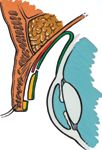Article
Techniques offer options for lid defects
An evolution in techniques for tarsoconjunctival flaps and grafts has provided reconstructive surgeons with a variety of effective options for addressing lid defects and other problems.

Keypoints:
Denver-An evolution in techniques for tarsoconjunctival flaps and grafts has provided reconstructive surgeons with a variety of effective options for addressing lid defects and other problems, said Michael J. Hawes, MD, FACS.

In addition, Dr. Hawes, a private practitioner in Denver, specializing in oculoplastic, facial, and reconstructive surgery, and clinical professor, Department of Ophthalmology, University of Colorado Health Sciences Center, Denver, summarized his 15-year experience with tarsoconjunctival flaps and grafts in a series of 111 eyes.

Other useful variations include the tarsal pillar flap for corneal protection and the mini-Hughes flap for covering an exposed anophthalmic socket, whereas rotational, advancement, and lateral and inferior conjunctival pedicle flaps are playing increasingly larger roles in eyelid reconstruction, Dr. Hawes said.
The study

The distribution of cases highlighted his changing preference toward free tarsoconjunctival grafts, which ultimately accounted for 70 of the 111 procedures, and his belief that the Hughes flap still is preferred in older patients and for larger defects. Compared with the eyes where a free tarsoconjunctival graft procedure was performed, the group with a Hughes flap was older on average (aged 73 years versus aged 63 years) and had larger defects (72% versus 52% of the lid).
"The biggest advantage of the free tarsoconjunctival graft is that it is a single-stage procedure, and so it is also chosen when that feature is important to the patient and feasible in the surgeon's opinion," Dr. Hawes said.
Further comparing the Hughes flap and free tarsoconjunctival graft, Dr. Hawes said that because the Hughes flap is classically covered with a skin graft while the free tarsoconjunctival graft usually is covered with a myocutaneous flap, the latter may have a better aesthetic outcome in terms of color and thickness match.
"However, taking the myocutaneous flap from the upper lid can result in asymmetry," he said.
Newsletter
Don’t miss out—get Ophthalmology Times updates on the latest clinical advancements and expert interviews, straight to your inbox.





